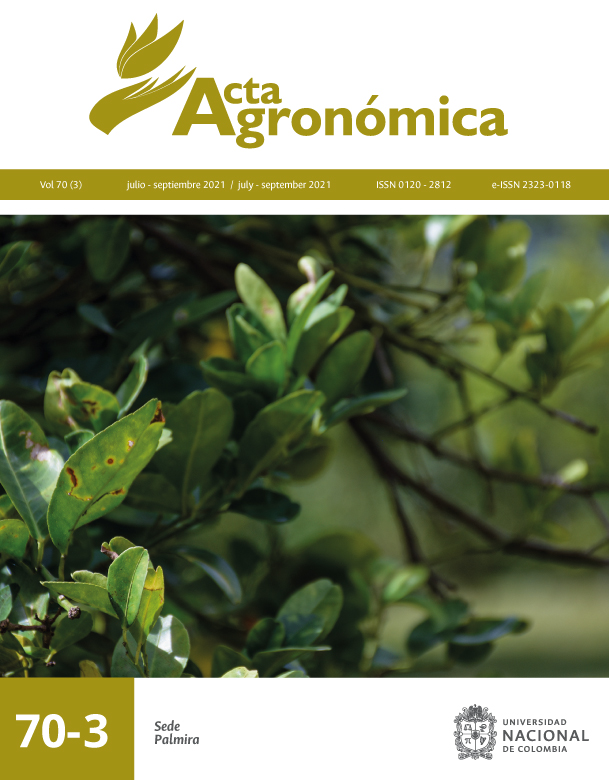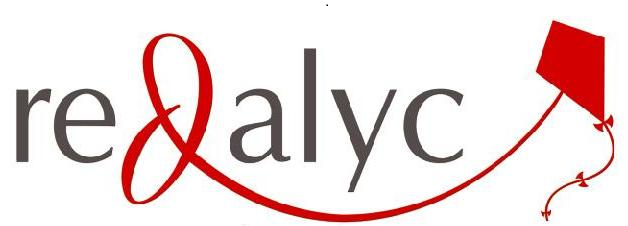Branch regeneration of jaborandi submitted to diferentes types of pruning and cropping systems
Regeneración de ramas de jaborandi sometidas a diferentes tipos de poda y sistemas de cultivo
DOI:
https://doi.org/10.15446/acag.v70n3.71835Keywords:
accessions, full sun, Pilocarpus microphyllus, pilocarpine, shade (en)accesos, pilocarpina, Pilocarpus microphyllus, pleno sol, sombra. (es)
Downloads
The leaf of the jaborandi (Pilocarpus microphyllus) is the part of the plant of economic interest, from which the pilocarpine is extracted, therefore, leaf production is the main variable that determines the productivity of this species. Pilocarpus leaf production can be managed during its development phase. Thus, the objective of the present study was to evaluate branch regeneration of jaborandi submitted to two types of cutting/pruning and different cropping systems. Prunings were carried out in jaborandi plants from different accessions from the Janorandi Active Germoplasm Bank (BGA), that were under different cropping systems, full sun and shade. With pruning shears, cuts were made 10 and 20 cm from the branch bifurcations. The results showed that regardless of the distances of the cuts in the jaborandi plants, the prunings benefited new shoots production and the harvest and influence on leaf production could be anticipated without harming the plant’s development. The drastic pruning performed on the species also stimulated efficient regeneration without damaging the plant, resulting in bigger leaf production, regardless of the pruning direction. It was also observed that jaborandi cultivation becomes more productive when it is grown under full sun regardless of the germplasm used, and the leaves can be harvested in all the months of the year.
La hoja del jaborandi (Pilocarpus microphyllus) es la parte de la planta de interés económico de la cual se extrae la pilocarpina, por lo que la producción de hojas es la principal variable que determina la productividad de esa especie. La producción de hojas del Pilocarpus puede ser manejada por medio de la poda de sus ramas durante su fase de desarrollo. Con base en esto, el objetivo del trabajo es evaluar la regeneración de ramas de jaborandi sometidas a dos tipos de cortes y bajo sistemas de cultivos diferentes. En este experimento se realizaron podas en plantas de jaborandi, provenientes de diferentes accesos del Banco Activo de Germoplasma (Bag) de jaborandi, que estaban bajo diferentes sistemas de cultivos, a pleno sol y sombra. Con el auxilio de tijera de poda, se realizaron cortes a la altura de 10 y 20 cm de distancia de las bifurcaciones de las ramas en plantas de jaborandi. Los resultados mostraron que independiente de las distancias de los cortes realizados, las podas beneficiaron el surgimiento de nuevas brotaciones, logrando anticipar la cosecha e influir en la producción de hojas sin perjudicar el desarrollo de la planta. La poda drástica realizada en la especie Pilocarpus microphyllus estimula una regeneración eficiente sin dañar la planta proporcionando mayor producción de hojas independiente de la dirección de la poda realizada en el arbusto. Se observa que el cultivo del jaborandi se vuelve más productivo cuando se cultiva a pleno sol independiente del germoplasma utilizado y la cosecha de las hojas puede ser realizada durante todos los meses del año.
References
Chibinga, O.C., Nyangito, M.M., Musimba, N.R.K., Simbaya, J., & Daura, M.T. (2016). Effect of coppicing levels on the re-growth of Julbernardia globiflora. Livestock Research for Rural Development, 28(3). http://www.lrrd.org/lrrd28/3/chib28042.htm
Correa de Moura, G., Vizzotto, M., Picolotto. L., & Corrêa Antunes, L. E. (2017). Production, physical-chemical quality and bioative compounds of misty blueberry fruit under different pruning intensities. Revista Brasileira de Fruticultura, 36(spe), 1-6. http://dx.doi.org/10.1590/0100-29452017158 DOI: https://doi.org/10.1590/0100-29452017158
Grabher, C. (2015). A governança e a sustentabilidade do extrativismo do jaborandi na Amazônia e transição para o cerrado e a Catinga. [Master’s disertation, Faculdade de ciências econômicas/ Universidade Federal do Rio Grande do Sul, Porto Alegre, Rio Grande do Sul]. http://www.lume.ufrgs.br/handle/10183/132942
Homma, A.K.O. (Ed.) (2014). Extrativismo vegetal na Amazônia: história, ecologia, economia e domesticação. Embrapa. https://www.embrapa.br/busca-de-publicacoes/-/publicacao/1016352/extrativismo-vegetal-na-amazonia-historia-ecologia-economia-e-domesticacao
Islam, M.S., Hossain, M.A. & Mondol, M.A. (2008). Effect of pruning and pollarding on shoot development in bakphul (Sesbania grandiflora L.). Journal of the Bangladesh Agricultural University, 6(2), 285-289. https://www.banglajol.info/index.php/JBAU/article/view/4823 DOI: https://doi.org/10.3329/jbau.v6i2.4823
König Brun, F.G., Jonas Longhi, S., Brun, E.J., Freitag, S.F., & Schumacher, M.V. (2007). Comportamento fenológico e efeito da poda em algumas espécies empregadas na arborização do Bairro Camobi. Revista da Sociedade Brasileira de Arborização Urbana, 2(1), 44-63. https://revistas.ufpr.br/revsbau/article/view/66238/38115 DOI: https://doi.org/10.5380/revsbau.v2i1.66238
Lima, D.F., Oliveira Silva, R.A., Alves Marques, L.G., Costa Véras, L.M., Simões, E.R.B., Leite, de Almeida Leite, J.R.S., Chaves Santos, M.R.M., & Pessoa, C. (2015). Technological forecasting of jaborandi (Pilocarpus microphyllus): economically important specie in the north and northeast of Brazil. GEINTEC, 5(1), 1626-1638. https://www.researchgate.net/publication/277641236_PROSPECCAO_TECNOLOGICA_DO_JABORANDI_Pilocarpus_microphyllus_ESPECIE_ECONOMICAMENTE_IMPORTANTE_NO_NORTE_E_NORDESTE_DO_BRASIL DOI: https://doi.org/10.7198/S2237-0722201500010003
Martins, F.D. (2015). O Conflito de Carajás: Cenários para a conservação da savana metalófila. [Master’s dissertation. Instituto de Pesquisas Jardim Botânico do Rio de Janeiro/ Escola Nacional de Botânica Tropical, Rio de Janeiro]. https://docplayer.com.br/22142344-O-conflito-de-carajas-cenarios-para-a-conservacao-da-savana-metalofila.html
Mendonça, T.R., Vieira da Mota, R., Souza, C.R., Dias, F.A.N., Azevedo Pimentel, R.M., & Albuquerque Regina, M. (2016). Pruning management of Chardonnay grapevines at high altitude in Brazilian southeast. Bragantia, 75(1), 57-62. http://dx.doi.org/10.1590/1678-4499.243 DOI: https://doi.org/10.1590/1678-4499.243
Ming, L.C., Ferreira, M.I., & Gonçalves, G.G. (2012). Pesquisas agronômicas das plantas medicinais da Mata Atlântica regulamentadas pela ANVISA. Revista Brasileira de Plantas Medicinais, 14 (spe),131-137. http://dx.doi.org/10.1590/S1516-05722012000500001 DOI: https://doi.org/10.1590/S1516-05722012000500001
Moreno Medina, B., Casierra Posada, F., & Blanke, M. (2016). Growth rates in blackberry (Rubus alpinus Macfad) plants under different pruning systems. Revista Colombiana de Ciencias Hortícolas, 10 (1), 28-39. http://dx.doi.org/10.17584/rcch.2016v10i1.4457 DOI: https://doi.org/10.17584/rcch.2016v10i1.4457
Moura, P.H.A., Coutinho, G., Pio, R., Bianchini, F.G., & Nogueira Curi, P. (2016). Plastic covering, planting density, and prunning in the production of cape gooseberry (Physalis peruviana L.) in subtropical region. Revista Caatinga, 29(2), 367-374. http://dx.doi.org/10.1590/1983-21252016v29n213rc DOI: https://doi.org/10.1590/1983-21252016v29n213rc
Nordstrom, B.L., Friedman, D.S., Mozaffari, E., Quigley, H.A., & Walker, A.M. (2005). Persistence and adherence with topical glaucoma therapy. American Journal of Ophthalmology, 140(4), 598-606. http://dx.doi.org/10.1016/j.ajo.2005.04.051 DOI: https://doi.org/10.1016/j.ajo.2005.04.051
Oliveira Silva, F.S., Castro Pereira, E., Mendonça, V., Medeiros da Silva, R. M., & Araujo Alves, A. (2017). Phenology and yield of the ‘roxo de valinhos’ fig cultivar in western potiguar. Revista Caatinga, 30(3), 802-810. http://dx.doi.org/10.1590/1983-21252017v30n329rc DOI: https://doi.org/10.1590/1983-21252017v30n329rc
Pedro, F.C. (2011). Podas em lavouras cafeeiras. [Master’s dissertation, Departamento de Agricultura da Universidade Federal de Lavras, Lavras, Minas Gerais]. https://www.emater.mg.gov.br/doc/intranet/upload/conhec_tecnico/monografia%20%20chico%20ufla.pdf
Pinheiro, C.U.B. (2002). Extrativismo, cultivo e privatização do jaborandi (Pilocarpus microphyllus Stapf ex Holm.; Rutaceae) no Maranhão, Brasil. Acta Botanica Brasilica, 16(2), 141-150. http://dx.doi.org/10.1590/S0102-33062002000200002 DOI: https://doi.org/10.1590/S0102-33062002000200002
Poudel P.R., Kataoka, I., & Mochioka, R. (2007) Effect of red- and blue-light- emitting diodes on growth and morphogenesis of grapes. Plant Cell Tissue and Organ Culture, 92(2), 147-153. https://www.researchgate.net/publication/225104137_Effect_of_red-_and_blue-light-emitting_diodes_on_growth_and_morphogenesis_of_grapes DOI: https://doi.org/10.1007/s11240-007-9317-1
Scarpare, J.A.F., Bordignon Medina, R., & Rodrigues da Silva, S. (2011). Poda de árvores frutíferas. Universidade de São Paulo, Casa do Produtor Rural. https://issuu.com/cidadesquerespiram/docs/poda_de___rvores_frut__feras
Silva, S. R., Buitrón, X., Oliveira, L.H., & Martins, M.V.M. (2001). Plantas medicinales de Brasil: aspectos generales sobre legislación y comercio. Ministério de Cooperação Econômica e Desenvolvimento da Alemanha e IBAMA. https://portals.iucn.org/library/sites/library/files/documents/traf-067.pdf
Thomaziello, R.A., & Pereira, S.P. (2008). Poda e condução do cafeeiro arábica. Instituto Agronômico, Série Tecnologia APTA, Boletim Técnico IAC, 203.
Weiss, B. M., Lameira, O.A., Martins, F.D., & Mendonça, M.V. (2011). A experiência promissora do projeto jaborandi-Parceria que promove Manejo, Conservação e Fortalecimento da Atividade Extrativista na Flona de Carajás. Ministério do Meio Ambiente.
Zaroni, M., Pontarolo, R., Abrahão, W.S.M., Fávero, M.L.D., Correa Júnior, C., & Stremel, D.P. (2004). Qualidade microbiológica das plantas medicinais produzidas no Estado do Paraná. Revista Brasileira Farmacognosia, 14(1), 29-39. http://www.scielo.br/pdf/rbfar/v14n1/a05v14n1 DOI: https://doi.org/10.1590/S0102-695X2004000100005
How to Cite
APA
ACM
ACS
ABNT
Chicago
Harvard
IEEE
MLA
Turabian
Vancouver
Download Citation
License
Copyright (c) 2022 Acta Agronómica

This work is licensed under a Creative Commons Attribution-NonCommercial-NoDerivatives 4.0 International License.
Política sobre Derechos de autor:Los autores que publican en la revista se acogen al código de licencia creative commons 4.0 de atribución, no comercial, sin derivados.
Es decir, que aún siendo la Revista Acta Agronómica de acceso libre, los usuarios pueden descargar la información contenida en ella, pero deben darle atribución o reconocimiento de propiedad intelectual, deben usarlo tal como está, sin derivación alguna y no debe ser usado con fines comerciales.






 >
> >
>



















